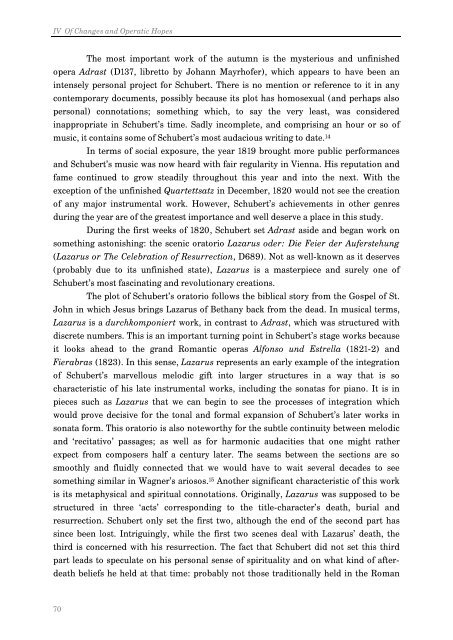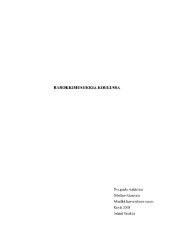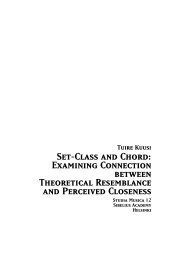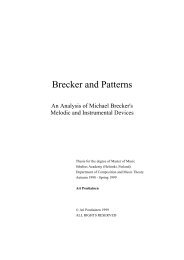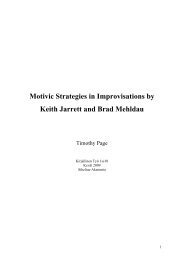The Unfinished Piano Sonatas of Franz Schubert Javier ... - Ethesis
The Unfinished Piano Sonatas of Franz Schubert Javier ... - Ethesis
The Unfinished Piano Sonatas of Franz Schubert Javier ... - Ethesis
Create successful ePaper yourself
Turn your PDF publications into a flip-book with our unique Google optimized e-Paper software.
IV Of Changes and Operatic Hopes<br />
70<br />
<strong>The</strong> most important work <strong>of</strong> the autumn is the mysterious and unfinished<br />
opera Adrast (D137, libretto by Johann Mayrh<strong>of</strong>er), which appears to have been an<br />
intensely personal project for <strong>Schubert</strong>. <strong>The</strong>re is no mention or reference to it in any<br />
contemporary documents, possibly because its plot has homosexual (and perhaps also<br />
personal) connotations; something which, to say the very least, was considered<br />
inappropriate in <strong>Schubert</strong>’s time. Sadly incomplete, and comprising an hour or so <strong>of</strong><br />
music, it contains some <strong>of</strong> <strong>Schubert</strong>’s most audacious writing to date. 14<br />
In terms <strong>of</strong> social exposure, the year 1819 brought more public performances<br />
and <strong>Schubert</strong>’s music was now heard with fair regularity in Vienna. His reputation and<br />
fame continued to grow steadily throughout this year and into the next. With the<br />
exception <strong>of</strong> the unfinished Quartettsatz in December, 1820 would not see the creation<br />
<strong>of</strong> any major instrumental work. However, <strong>Schubert</strong>’s achievements in other genres<br />
during the year are <strong>of</strong> the greatest importance and well deserve a place in this study.<br />
During the first weeks <strong>of</strong> 1820, <strong>Schubert</strong> set Adrast aside and began work on<br />
something astonishing: the scenic oratorio Lazarus oder: Die Feier der Auferstehung<br />
(Lazarus or <strong>The</strong> Celebration <strong>of</strong> Resurrection, D689). Not as well-known as it deserves<br />
(probably due to its unfinished state), Lazarus is a masterpiece and surely one <strong>of</strong><br />
<strong>Schubert</strong>’s most fascinating and revolutionary creations.<br />
<strong>The</strong> plot <strong>of</strong> <strong>Schubert</strong>’s oratorio follows the biblical story from the Gospel <strong>of</strong> St.<br />
John in which Jesus brings Lazarus <strong>of</strong> Bethany back from the dead. In musical terms,<br />
Lazarus is a durchkomponiert work, in contrast to Adrast, which was structured with<br />
discrete numbers. This is an important turning point in <strong>Schubert</strong>’s stage works because<br />
it looks ahead to the grand Romantic operas Alfonso und Estrella (1821-2) and<br />
Fierabras (1823). In this sense, Lazarus represents an early example <strong>of</strong> the integration<br />
<strong>of</strong> <strong>Schubert</strong>’s marvellous melodic gift into larger structures in a way that is so<br />
characteristic <strong>of</strong> his late instrumental works, including the sonatas for piano. It is in<br />
pieces such as Lazarus that we can begin to see the processes <strong>of</strong> integration which<br />
would prove decisive for the tonal and formal expansion <strong>of</strong> <strong>Schubert</strong>’s later works in<br />
sonata form. This oratorio is also noteworthy for the subtle continuity between melodic<br />
and ‘recitativo’ passages; as well as for harmonic audacities that one might rather<br />
expect from composers half a century later. <strong>The</strong> seams between the sections are so<br />
smoothly and fluidly connected that we would have to wait several decades to see<br />
something similar in Wagner’s ariosos. 15 Another significant characteristic <strong>of</strong> this work<br />
is its metaphysical and spiritual connotations. Originally, Lazarus was supposed to be<br />
structured in three ‘acts’ corresponding to the title-character’s death, burial and<br />
resurrection. <strong>Schubert</strong> only set the first two, although the end <strong>of</strong> the second part has<br />
since been lost. Intriguingly, while the first two scenes deal with Lazarus’ death, the<br />
third is concerned with his resurrection. <strong>The</strong> fact that <strong>Schubert</strong> did not set this third<br />
part leads to speculate on his personal sense <strong>of</strong> spirituality and on what kind <strong>of</strong> afterdeath<br />
beliefs he held at that time: probably not those traditionally held in the Roman


